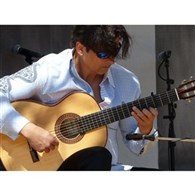Welcome to one of the most active flamenco sites on the Internet. Guests can read most posts but if you want to participate click here to register.
This site is dedicated to the memory of Paco de Lucía, Ron Mitchell, Guy Williams, Linda Elvira, Philip John Lee, Craig Eros, Ben Woods, David Serva and Tom Blackshear who went ahead of us.
We receive 12,200 visitors a month from 200 countries and 1.7 million page impressions a year. To advertise on this site please contact us.
|

|
|
East is east
|
You are logged in as Guest
|
|
Users viewing this topic: none
|
|
Login  | |
|

  
Piwin
Posts: 3559
Joined: Feb. 9 2016

|
 RE: East is east (in reply to Brendan) RE: East is east (in reply to Brendan)
|
|
|
Not familiar all that much with traditional Japanese music.
But I wouldn't minimize the importance of timbre in Western "classical" music. Especially with certain composers of the late 19th century (Debussy, Mahler, etc.).
He may be right that "the trajectory of Western instruments has long held the goal of equalizing the sound quality across the full range of the instrument", but, the fact is that that goal was never reached. To put it simply, you could write a complexe orchestration on a computer program or synth, it could sound great on the digital feedback, but then when you have it played live by a real orchestra it might sound like crap. It's patently obvious with most brass instruments. On a synth, you can play those instruments as high as you want and still have them sound "soft". Play those same high notes with the real instruments and there's no getting around the screaming, almost grating, quality of sound they will produce. As a result, the "musical language developed to acommodate those differences" in timbre between pitches, just like he says it did in Japanese music. Dunno, maybe he's right that certain Western musicians feel the "urgency to fix the natural sounds of musical instruments". But the fact remains that they haven't been "fixed", every instrument has its own physical limitations and a good composer takes those into account.
As for his "ma", I see it, and I raise him Cage's 4'33. 
As for the comparison with flamenco guitar, I tend to think that the main component of aesthetics here is rythm. The difference you make between "texture and timbre" and "strong melody" in my mind is really just the difference between accompaniment and falsetas.
_____________________________
"Anything you do can be fixed. What you cannot fix is the perfection of a blank page. What you cannot fix is that pristine, unsullied whiteness of a screen or a page with nothing on it—because there’s nothing there to fix."
|
|
|
|
REPORT THIS POST AS INAPPROPRIATE |
Date Feb. 23 2018 15:01:14
 |
|

   
kitarist
Posts: 1715
Joined: Dec. 4 2012

|
 RE: East is east (in reply to Brendan) RE: East is east (in reply to Brendan)
|
|
|
quote:
ORIGINAL: Brendan
Is this true:
https://nmbx.newmusicusa.org/elements-of-japanese-music/
I am skeptical about the claim that the west pushed for consistent timbre across an instrument range (and, really, the first example is the piano/keyboard which is about the only "western" instrument without any ability to vary timbre due to the indirect way of producing the sound). This might be true in the context of large orchestral performances (however the author just states it in general, and without providing evidence), but not for chamber or solo works. I can see how, for large orchestras, a composer might work with "fixed" timbres in their mind (one per type of instrument) to create layers and textures using different types of instruments. Not so for chamber and solo works. None of this is addressed in the article.
Further not helping matters, the author provides a guitar-like instrument as the example for east embracing its timbre variability. But the ("western") guitar has the same embrace and employ of timbre variability, so I am not convinced there is an east-west difference there in a solo or chamber context - or at least, if the thesis re: timbre is correct, this is not a very good way to argue it.
_____________________________
Konstantin
|
|
|
|
REPORT THIS POST AS INAPPROPRIATE |
Date Feb. 23 2018 15:44:53
 |
|

   
kitarist
Posts: 1715
Joined: Dec. 4 2012

|
 RE: East is east (in reply to Brendan) RE: East is east (in reply to Brendan)
|
|
|
I think in general there are identifiable differences in Japanese vs. western art aesthetics, but I was worried it was just some confirmation bias from recognizing examples and elements as I was reading this. However now that I looked around for actual research, I found some interesting bits and pieces. Still, "Almost any general statement made about Japanese aesthetics can easily be disputed and even disproved by citing well-known contrary examples." Keene (1969).
Some interesting (or pithy) quotes from research papers. A number of these ideas resonate with the flamenco experience actually.
"while the Western culture typically “believes in control of nature” and “romanticizes technology,” the Japanese culture “believes in the fundamental uncontrollability of nature” and “romanticizes the nature” (Koren, 2008, p.27)
Some from Keene (1969):
"A number of headings under which Japanese aesthetics might be discussed come to mind: suggestion, irregularity, simplicity, and [impermanence]."
"Beginnings that suggest what is to come, or ends that suggest what has been, allow the imagination room to expand beyond the literal facts to the limits of the capacities of the reader of a poem, the spectator at a Noh play, or the connoisseur of a monochrome painting."
"The emphasis on beginnings and ends implied a rejection of regularity as well as of perfection."
"By choosing suggestion and simplicity the Japanese forfeited a part of the possible artistic effects, but when they succeeded they created works of art of a beauty unaffected by the shifting tides of taste."
"Beyond the preference for simplicity and the natural qualities of things lies what is perhaps the most distinctively Japanese aesthetic ideal, perishability. [...] The visible presence of perishability in the cracked tea bowl carefully mended in gold has been appreciated not because it makes the object an indisputable antique, but because without the possibility of aging with time and usage there could be no real beauty."
Now from The Moral Dimension of Japanese Aesthetics (2007) by Saito:
"Japanese aesthetic concepts, such as wabi, sabi, yugen, iki, and mono no aware, have become better known, some even popularized today. [...] The authors of all these studies generally characterize Japanese aesthetics by focusing on aesthetic concepts and phenomena that are "unique to" Japan and ''different from" non-Japanese aesthetic traditions, the Western aesthetic tradition in particular. [...] I characterize the long-held Japanese aesthetic tradition to be morally based by promoting respect, care, and consideration for others, both humans and nonhumans."
"Concern for the aesthetic in our everyday life is neither frivolous nor trivial. It has a close connection to the moral dimension of our lives. Eaton points out that, ultimately, there is a "connection between being a person who has aesthetic experience and being a person who has sympathies and insights of a kind required for successful social interaction.""
Keene, D. 1969. Japanese Aesthetics. Philosophy East and West, Vol. 19(3), pp. 293-306.
Koren, L. (2008). Wabi-sabi for artists, designers, poets & philosophers.
Saito, Y. (1997). The Japanese aesthetics of imperfection and insufficiency. The Journal of Aesthetics and Art Criticism, 55(4), 377-385.
Saito, Y. (2007). The moral dimension of Japanese aesthetics. The Journal of aesthetics and art criticism, 65(1), 85-97.
_____________________________
Konstantin
|
|
|
|
REPORT THIS POST AS INAPPROPRIATE |
Date Feb. 24 2018 17:43:17
 |
|

   
estebanana
Posts: 9351
Joined: Oct. 16 2009

|
 RE: East is east (in reply to kitarist) RE: East is east (in reply to kitarist)
|
|
|
quote:
"while the Western culture typically “believes in control of nature” and “romanticizes technology,” the Japanese culture “believes in the fundamental uncontrollability of nature” and “romanticizes the nature” (Koren, 2008, p.27)
This is also totally wrong. East and West views in Japan on the control of nature are surprisingly similar. Whoever wrote that is setting up a simplistic binary opposition that serves their point, its not true at all. Each of these vantage points on the romantic and the control of nature exist concurrently in West and East. This Koren person does not know what they are talking about. It's not unusual to find Japanese scholars who are not knowledgeable on the West to make snap comparisons about aesthetic value. Wade deep into some literary references and its easy to parse out. Both East ad West share a multiplicity of vantage points on the control of nature.
If someone s trying to set up a reason, which is not needed, for the development of instruments with less regard for timbre consistency in the East, the place to look is the time line of the industrial revolution. It's not a function of romantic vs non romantic in nature, it's more practical than that. Eastern culture is defined by it's writing systems, in the West the writing system is streamlined and naturally lends itself to be mechanically reproduced, so mechanical reproduction began earlier. In Asia language is culture, it's inseparable, and to not use mechanical means to reproduce language ( books) was not a function of inherent romanticism for nature, it was a conformation of the pragmatic order of society. Music exists both inside and outside this idea.
_____________________________
https://www.stephenfaulkguitars.com
|
|
|
|
REPORT THIS POST AS INAPPROPRIATE |
Date Feb. 26 2018 2:56:55
 |
|
 New Messages New Messages |
 No New Messages No New Messages |
 Hot Topic w/ New Messages Hot Topic w/ New Messages |
 Hot Topic w/o New Messages Hot Topic w/o New Messages |
 Locked w/ New Messages Locked w/ New Messages |
 Locked w/o New Messages Locked w/o New Messages |
|
 Post New Thread
Post New Thread
 Reply to Message
Reply to Message
 Post New Poll
Post New Poll
 Submit Vote
Submit Vote
 Delete My Own Post
Delete My Own Post
 Delete My Own Thread
Delete My Own Thread
 Rate Posts
Rate Posts
|
|
|
Forum Software powered by ASP Playground Advanced Edition 2.0.5
Copyright © 2000 - 2003 ASPPlayground.NET |
0.078125 secs.
|


 Printable Version
Printable Version











 New Messages
New Messages No New Messages
No New Messages Hot Topic w/ New Messages
Hot Topic w/ New Messages Hot Topic w/o New Messages
Hot Topic w/o New Messages Locked w/ New Messages
Locked w/ New Messages Locked w/o New Messages
Locked w/o New Messages Post New Thread
Post New Thread